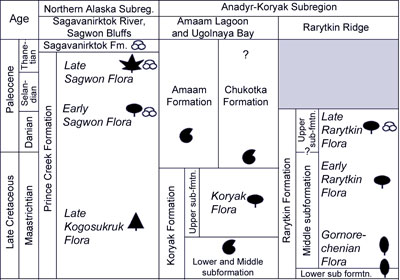Correlations
| North Pacific | AKSR-NASR | Anadyr-Koryak | Verkhoyansk-Chukotka | Okhotsk-Chukotka | N. Alaska | Yukon | Chignik |
|---|---|---|---|---|---|---|---|
| Phytostratigraphy | |||||||
The Gornorechenian Phase of Floral EvolutionThis phase has been initially distinguished in a publication by Nesov and Golovneva (1990) who included in it the Kakanaut taphoflora of the Pekul'neiskoe Lake site, the Vysokorechenskaya taphoflora of the Khatyrka River section, and the Gornorechenskaya taphoflora of the northern Rarytkin Ridge. The Gornorechenskaya taphoflora is the type flora of the phase (Nesov and Golovneva,1990; Golovneva, 1994a, 1994b). The impoverished (eight species) Vysokorechenskaya taphoflora, lacking characteristic taxa of the type flora, is tentatively attributed to this phase. There is no continuous section with successive taphofloras, in which the boundary between the Barykov and Gornorechenian phases can be defined. Based on marine biostratigraphic dating, the Kakanaut and Vysokorechenskaya taphofloras of the Gornorechenian phase are separated from the Verkhnebystrinskaya and Barykov taphofloras of the Barykov phase by a time interval corresponding to the last half of the Campanian and earliest Maastrichtian (7 – 8 m.y. in total). Floras of this time span are unknown in the AKSR, and it is unclear, therefore, whether there is a transitional flora undiscovered so far, or the Gornorechenian phase follows immediately the Barykov phase, the former being separated from the latter somewhere within the indicated stratigraphic interval. In the northern Rarytkin Ridge, the base of the Rarytkin Formation is not in the lower Maastrichtian (Golovneva, 1994a, 1994b), but at the late Campanian (Volobueva and Terekhova, 1974; Terekhova and Dundo, 1987; Pokhialainen, 1994), and the flora of the lower Rarytkin Subformation (the early Gornorechenian floral assemblage in the terminology of Golovneva) accordingly antedates, but does not corresponds in age to, the middle Maastrichtian. Consequently, the Gornorechenian phase commenced in the second half of the Campanian and was approximately 7 – 8 m.y. long. Plant taxa of the flora are listed in the panel to the right. The genera Ettingshausenia and Arthollia are representatives of large-leaved platanoids in the Gornorechenian floral phase, when Pekulnea, Trochodendroides, Celastrinites, Cissites, Liriophyllum, Renea, Platimelis, Dyrana, Viburnum, and Quereuxia prevailed among angiosperms and Corylites appeared. Equisetum arcticum is a common component of this flora, while ferns are represented by single specimens of Osmunda sp. Frequent Ginkgo remains and cycadophytes Nilssonia and Encephalartopsis likely formed monodominant communities at that time. According to Vassilevskaya (1963), cycadophytes represent up to 20% of the plant remains in the Kakanaut taphoflora. Typical Late Cretaceous taxa Parataxodium, Cryptomerites, Elatocladus smittiana, and Sequoia minuta prevailed among conifers of the Gornorechenian phase and occur in association with younger genera Metasequoia, Glyptostrobus, Taxodium, Mesocyparis, and Thuja. Comparing floras of the Gornorechenian and older Barykov phases, Golovneva (1994a), (p. 48) came to the conclusion that "… gymnosperms remained practically of the same composition, while angiosperms changed significantly and had a few taxa in common". The abundance of endemic genera and species, especially among angiosperms, is a distinctive feature of the Gornorechenian flora that includes 64 identified taxa and may be even a little more diverse (75 species), because not all the fragmented plant remains of the Kakanaut taphoflora have been identified (Golovneva, 1994a).
|
|
||
|


